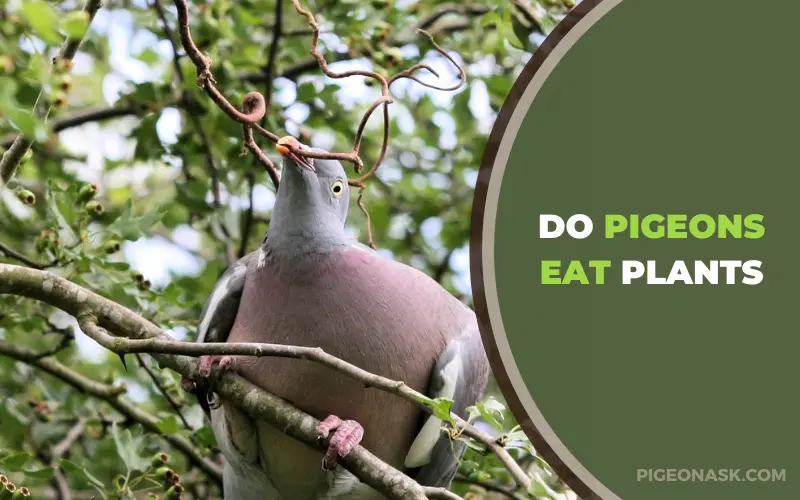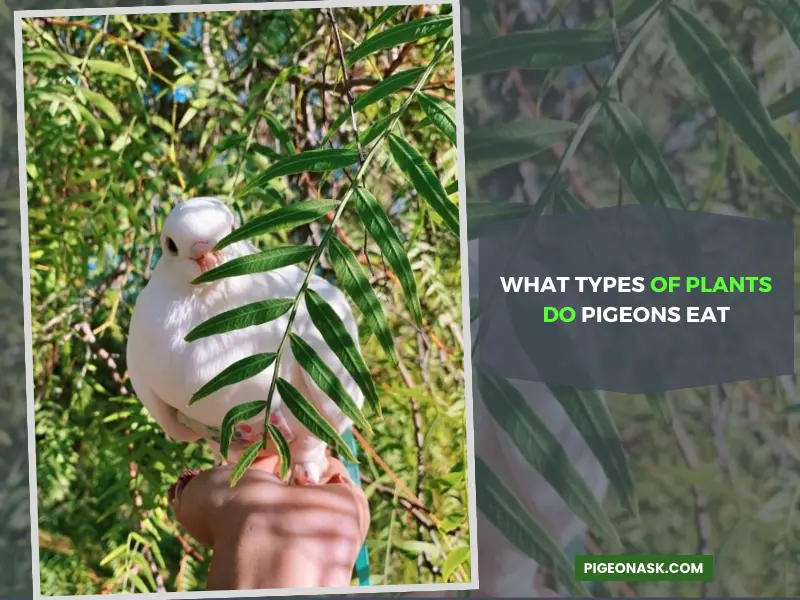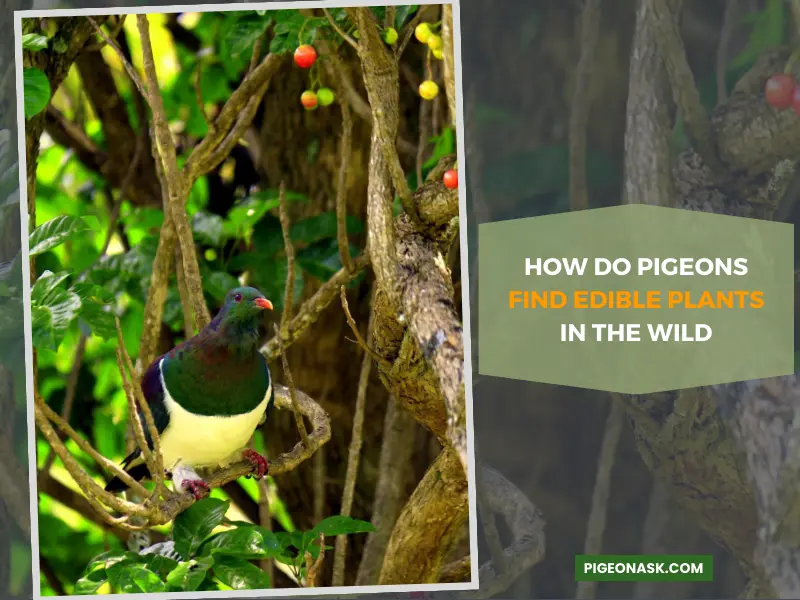Do Pigeons Eat Plants?
It’s easy to imagine pigeons munching on earthworms and crispy insects. Given the nature of pigeons, can you imagine them eating plants though?
It’s hard to visualize a pigeon with a diet of greens, yet pecked and half-eaten leaves tell a whole different story.
With all that, it’s pretty reasonable to deny the possibility and wonder, do pigeons eat plants? Yes, they do. Not regularly like their life depends on it, but eating plants isn’t an uncommon trait for pigeons.

No matter how weird it sounds, pigeons have their reasons for this strange habit. And what are the reasons, you may ask? Well, this is what we’re here to discuss, with a lot more details about the wild plant-based diet of our feathered friend.
Looking for more articles about pigeon food:
Do Pigeons Eat Plants Naturally?
Yes, pigeons eat plants naturally. Although they rely heavily on grains and seeds to get the most of their regular nutrients, sometimes these are not enough.
They need more, and plants seem like the second best option to get the minerals and nutritional elements straight from the earth.
What Types of Plants Do Pigeons Eat?
When we’re saying pigeons eat plants, we don’t necessarily mean every type of plant.
Just like us humans and almost all herbivores out there, pigeons have a list of plants they can’t get enough of, a lot of plants they’ll never touch, and more plants they shouldn’t be allowed near to touch.

The plants preferred and eaten by pigeons can be narrowed down to several specific types.
Now, what types of plants do pigeons commonly eat? You’ll mostly see them nibbling on cole crops and veggie leaves.
Pigeons usually eat greens we humans grow and consume for our own benefit, and they’re prudent in that way. Here, the types are discussed more elaborately below –
Berry
Berries like currant and cherry fall under this category. Pigeons love berries, but they should have them in limited portions as the seeds carry a small amount of cyanide compound in them. This is nothing for the humans but detrimental for the birds.
Pigeons scavenge for berry plants, mostly in winter when other sources of food are scarce and there’s nothing good to eat on the ground. Berries contain antioxidants and offer sufficient calories to keep them warm in cold weather.
Apart from the foot, they might sometimes take a bite or two from the leaves.
Brassica
Brassica, more popularly known as cole crops, happens to be pigeon’s top favorite plant type to eat. Cabbages, lettuce, cauliflower, broccoli, Brussels sprouts, and watercress, these birds will eat anything with a stock, stem, and crunchy leaves.
They enjoy pecking at these vegetables as they’re relishing and nutritious; they also dabble as a fun activity for hours.
These vegetables are fibrous, so they are good for the digestive system. They are full of vitamins like A and K and minerals like manganese. If not anything else, pecking on the stems and leaves keeps the pigeons active.
Leafy Vegetables
Pigeons are quite fond of kale and spinach. Both of these leafy vegetables contain vitamins A, C, and K in balanced proportions. While kale is full of antioxidants, spinach provides them with essential minerals like potassium and calcium.
Legumes
You might catch them eating peas and beans as well. Pigeons go for legumes like peas mostly when they’re in need of protein intake in their diet. These fibrous plants are also a great source of vitamins A and C.
Root Vegetables
Vegetables like beets and turnips are favored by pigeons for their rich supply of minerals. Pigeons eat both vegetables, stems, and leaves for a fair proportion of calcium, potassium, and magnesium.
They love the leaves of the beets for the antioxidants they provide. These are the types of plants you’ll spot pigeons eating all the time.
Mostly in winter, when their regular food sources are scant, or their meals fail to supply the essential minerals or vitamins. Pigeons are born with this fascinating instinct of spotting the plants that might be the most beneficial for them.
See our in-depth “Pigeon Foods and Diet” article to learn what these urban birds eat. We cover their dietary habits and nutrition.
Do Pigeons Eat Houseplants?
It’s almost funny how despite having a strong sense of what to eat, pigeons can’t resist the urge to experiment with other plants simply because they look edible.
And this includes our houseplants too. If it’s green, appealing, and angiosperm-y enough, don’t be surprised when a pigeon around you is eyeing its leaves or the fruits.

Especially if you happen to have a garden of fruits and vegetables, count on the pigeons to peck on the stems and leaves on a regular basis.
This is basically a nightmare for farmers and gardeners, as they eat like savages and damage the plants in the process.
The only way to protect the houseplants is to either spray their surroundings with taste deterrents and bird repellents, put netting over and around the plants, or keep them inside if possible.
Besides, you should keep pigeons away from your houseplants for their own safety. Most of the houseplants are full of toxins that are deadly for the birds.
Are There Certain Plants that Are Harmful to Pigeons?
Yes, there are certain plants that are harmful to pigeons. Most houseplants, for instance, as mentioned before. While many plants seem safe to us humans, they’re equally fatal for the bird immune system.
If we go by the name, it will be more than 100 names just for the common plants around us; these plants can be narrowed down to the following types, given their lethal nature –
| Harmful Part | Plant(s) |
|---|---|
| All Parts | Blue-green Algae, Calla Lily, Castor Bean, Christmas Cherry, Dieffenbachia, Elephant’s Ear, Ergot, Foxglove, Jerusalem Cherry, Jimsonweed, Lily of the Valley, Milkweed, Mistletoe, Nightshade, Oak, Oleander, Philodendron, Rhododendron, Tobacco |
| Berries | Pokeweed, Virginia Creeper |
| Leaves | Avocado, Black Locust, Coffee Beans, Chocolate Beans, Eggplant, Locoweed, Pokeweed, Potato, Tea, Virginia Creeper, Yew |
| Pits | Avocado |
| Roots | Pokeweed |
| Seeds | Black Locust, Yew |
| Stems | Avocado, Eggplant, Potato |
| Sprouts | Eggplant, Potato |
| Unripe Fruits | Avocado |
| Wood | Black Locust, Yew |
How Do Certain Plants Harm Pigeons?
Pigeons resort to eating plants for nutrition. Apart from the ones containing the elements these birds are seeking, many plants contain several types of toxins, most of which will either kill them right away or slowly with agonizing symptoms.
Most plant-based sicknesses and deaths of pigeons can be traced back to toxins like oxalates, glycosides, solanine, atropine, and several other deadly variants of alkaloids.
Pigeon’s immune system reacts differently to these different variants. Here are more details on what the pigeons have to deal with when it comes to the most prominent types of toxins present in plants like the following –
Weakening Toxins
The elements responsible for making pigeons weak and depressed can’t be narrowed down to one specific toxin. In fact, a few variants are still unknown to researchers to this date.
The only confirmed observation is that toxins in avocados, black locusts, and rhododendrons often make the birds feeble and less enthusiastic about their regular activities.
Oxalates
This toxin is bad for the pigeon’s digestion system. Calla lily, dieffenbachia, elephant’s ear, and philodendron plants have oxalates in them.
Oxalate intake can often result in swallowing issues and oral irritation, and sometimes, the birds can’t stop vomiting.
Saponin
Saponin is found in pokeweed. While this toxin is pretty rare, that doesn’t make its effects any less damaging. Saponin is responsible for causing vomiting and extreme tremors, often leading the bird to collapse.
Theobromine
We love chocolate and can’t live without our coffee, but these elements are literal grim rippers for pigeons. Cocoa and caffeine are full of theobromine.
This toxin leads the birds to have extreme diarrhea and, in worst-case scenarios, nervous system breakdown, seizure, respiratory issues, or heart failure.
Solanine
Solanine is one of the deadliest toxins for pigeons and is found in Christmas cherry, eggplant, Jerusalem cherry, potato, and tomato plants.
This toxin is responsible for dilating the pupils and stopping urine production. Consuming plants with solanine in them can also cause fatal seizures and paralysis.
Glycosides and Alkaloids
Glycoside and alkaloid-based toxins are super lethal for the pigeon’s immune system. Castor bean, Christmas cherry, eggplant, ergot, foxglove, lily of the valley, milkweed, nightshade, oleander, potato, tomato, and yew plants are structured with glycosides or alkaloids.
The complex compounds of these toxins can meddle with breathing and sometimes even collapse the heart.
Some Other Variants
Apart from the most common ones, the aftermath of consuming variants like Anatoxin A or Oxalic Acid is equally messy.
Found in blue-green algae, Anatoxin causes disruption in motor functions, leaving the birds unable to actively operate their limbs, swim, or fly. Virginia creepers contain oxalic acid, the toxin solely responsible for renal failure.
How Do Pigeons Find Edible Plants in the Wild?
Pigeons are smart and they’re natural foragers. By instinct and genetic experience, these birds can tell which plants will potentially serve their needs and they’re always on the look for those types while soaring in the wild.

They walk on the grounds and fly around potential trees for the right fruits, stems, or leaves.
Pigeons use their nervous system to spot edible plants. Research has shown that they use different eyes to scavenge for fruits and vegetables.
Also, through centuries of observation, they’ve picked up the notion that humans grow and harvest edible crops. So, they often lurk around the crop fields to get a nibble of the harvested goods.
Do Pigeons Need to Eat Plants in Order to Be Healthy?
Pigeons aren’t necessarily dependent on plants in order to be healthy, but it’s an organic source of nutrition. As we discussed at first, pigeons eat plants when their primary meals aren’t able to provide enough nutrients.
Mostly calcium, pigeons basically go for the greens when their body is craving calcium.
Moreover, potassium and magnesium are required to maintain healthy, fluffy feathers. Pigeons get them from leafy and root vegetables like kale, spinach, or beet. Many plants consumed by them are an excellent source of vitamins A, C, and K.
Final Takeaway
It’s amazing how resourceful these birds can get when they need to be. And it’s difficult to fathom at first whether pigeons eat plants, but it is not hard to see once you know the reasons.
It might be tragic for you as a gardener or farmer, but try to protect your plants without harming the little souls.
Be careful about pesticides, you might end up killing the birds in the process. And if you’re an owner of pigeons, please keep an eye out for the plants around your pigeons. As you know, not all plants are their friends.
For more updates on the fascinating habits of these birds, follow us on Facebook, Twitter, and Pinterest.
